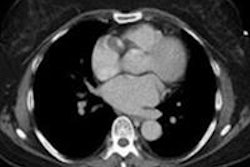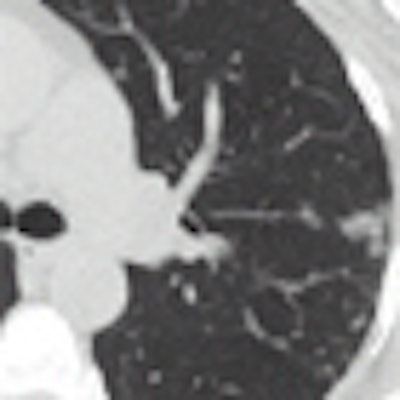
Adaptive image filtering can improve CT image quality and reduce image noise, enabling radiologists to lower radiation dose, concluded a study presented at this week's American Roentgen Ray Society (ARRS) meeting in San Diego.
Dr. Sarabjeet Singh and colleagues from Massachusetts General Hospital in Boston scanned consenting patients four times each rather than relying on phantoms to acquire chest images at a variety of dose settings.
Compared with other dose-reduction methods, filters are the easiest to use because they require only that the user select one of the preset settings, which are then applied automatically, Singh said. In an interview with AuntMinnie.com, he described the 2D adaptive filtering software used (SharpView CT, ContextVision, Stockholm, Sweden).
"The filter divides the images into different frequencies based on different structures in the image," he said. "Big structures such as the heart or lungs or small structures have different frequencies, and [the software] processes the image data in different frequency ranges."
Once these frequencies are acquired separately, the algorithm analyzes the image data at the pixel level to tease out different traits, interpolate the data, and perform other functions, he said.
The study included 12 patients (mean age, 63.1 ± 6.2 years; 5 male, 7 female; average weight, 86.7 ± 20.5) who each received four CT scans at different levels of radiation dose in the chest and abdomen.
- Chest mAs settings: 150, 100, 75
- Abdomen mAs settings: 200, 150, 100, 50
Each of the four scans was acquired at the same identical location on the patient, and the additional exposures covered only "the most subtle detected lesion" with a limited scan length of 10 cm.
The 10-cm additional acquisitions served to minimize the amount of tissue that was re-exposed, Singh said. When all of the images had been acquired, they were processed using the 2D adaptive filters.
Each image series was examined for noise, artifacts, contrast, and lesion size and conspicuity, as well as CT attenuation, the authors wrote. The data were analyzed using a Student's t-test.
All 18 lesions (most smaller than 1 cm) were seen on both unprocessed and processed CT exams, the group reported. There was no significant difference between CT numbers, lesion conspicuity, and visibility of small structures between processed and unprocessed low-dose images (p > 0.05).
Regardless of radiation dose, postprocessing with image filters improved subjective noise for both chest and abdominal CT and helped lower CT radiation dose levels for the chest by up to 40 mAs and for the abdominal CT by up to 100 mAs, Singh said.
The quantitative average image noise in postprocessed low-dose chest and abdominal CT images was significantly lower than in low-dose unprocessed images (p < 0.001).
Filter versus no filter: Abdomen
|
||||||||||||||||
Filter versus no filter: Chest
|
||||||||||||||||
Although the diagnostic confidence of low-dose postprocessed images was high at 40 mAs for chest CT, postprocessed abdominal CT images were rated as "fully confident" only at 100 mAs and not 50 mAs, the group reported.
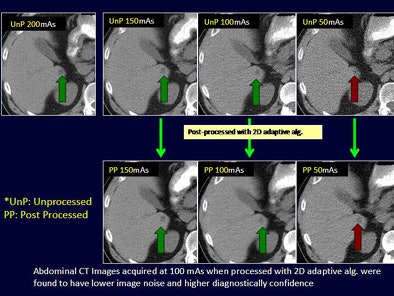 |
| All images courtesy of Dr. Sarabjeet Singh. |
 |
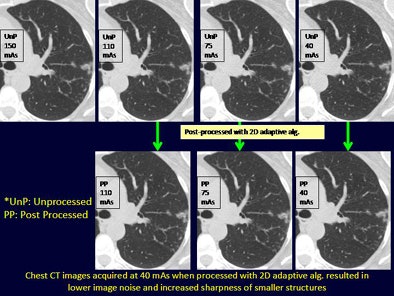 |
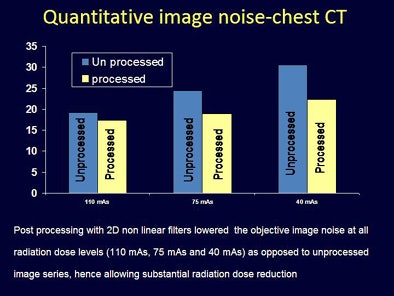 |
Adaptive filtering decreases image noise and enhances the diagnostic confidence of low-dose chest (40 mAs) and abdominal (100 mAs) CT exams, they concluded.
"Using the filters, we can reduce the radiation dose by 75% in the chest and by 50% in the abdomen," Singh said. "They can be used on any scanner."
Use of the software will be implemented facilitywide once it has been purchased and installed on every scanner at Massachusetts General Hospital, Singh said.
By Eric Barnes
AuntMinnie.com staff writer
May 6, 2010
Related Reading
Reduced dose can still yield acceptable pediatric CT images, April 22, 2010
Automated exposure control delivers uneven CT dose reduction, April 15, 2010
CT doses, widely variable in Europe, are reduced by staff efforts, March 6, 2010
DSCT technique distinguishes 'rainbow' of kidney stone types, January 4, 2010
ASIR cuts dose in Crohn's disease patients, December 4, 2009
Copyright © 2010 AuntMinnie.com







